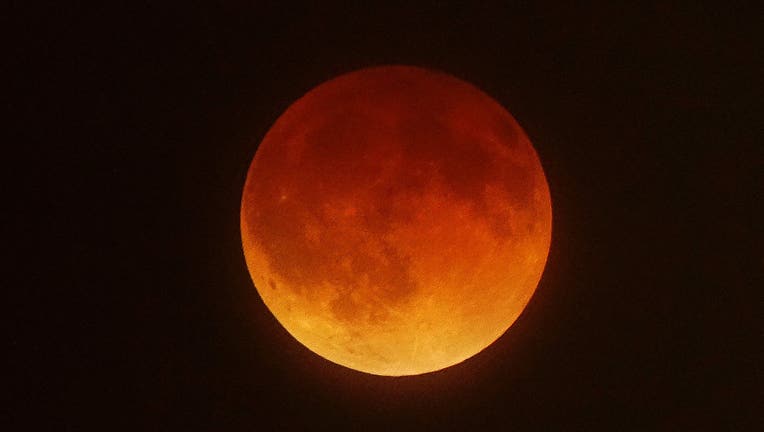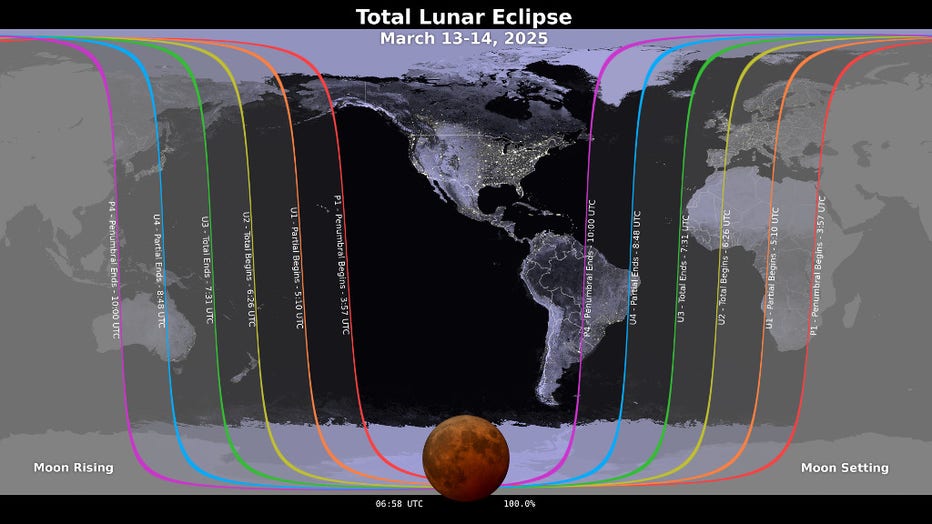Total lunar eclipse will be visible from the Bay Area tonight. Here's how to stream

TOPSHOT - Lunar eclipse of the moon underway over southern California as seen from Korea town, west of downtown Los Angeles early on April 15, 2014. The entire event was to be visible from North and South America, but sky watchers in northern and and
OAKLAND, Calif. - A total lunar eclipse will be visible across the U.S. and North America Thursday night.
Lucky for Californians, and those who live in Pacific Standard Time, you can step outside just before midnight to catch a glimpse.
If you'd rather watch the total lunar eclipse from the comfort of your home, the Southern California-based Griffith Observatory will be streaming the event in its entirety.
How to watch the total lunar eclipse from home
What we know:
The celestial event will be streamed on the observatory's YouTube page starting at 8:50 p.m. Thursday.
While the total eclipse doesn't start until 11:26 p.m., you can stream every stage of the eclipse until 3:05 a.m.
Lunar eclipse timeline
6:44 p.m. – Moonrise
8:50 p..m. – Online broadcast begins
8:57 p.m. – Penumbral eclipse begins
10:09 p.m. – Umbral eclipse begins
11:26 p.m. – Total eclipse begins
11:59 p.m. – Greatest Eclipse
12:31 a.m. – Total eclipse ends
1:48 a.m. – Umbral eclipse ends
3 a.m. – Penumbral eclipse ends
3:05 a.m. – Online broadcast ends
Lunar eclipse visibility
The lunar eclipse will be visible across all 50 U.S. states, according to Space.com. A map from NASA outlines global visibility.

Lunar eclipse visibility map from NASA on March 13-14. The celestial event will be visible in the Americas.
Why will the moon look red?
Dig deeper:
Even though the moon will be in Earth's shadow during the eclipse, our planet won't quite block out all of the sun's light. Our atmosphere will filter out all but the reddish wavelengths of the remaining light – the same effect that makes our sunrises and sunsets red. As a result, the moon will take on a reddish-brown glow. This is why it’s called a "Blood" Worm Moon, as opposed to just a regular Worm Moon.
If the lunar eclipse wasn’t taking place on the same night as the full moon, it would just be called a Worm Moon, according to NASA.
Why is it called a Worm Moon?
March’s full moon is called the Worm Moon.
It was believed this name was given due to the earthworms that appeared as the soil warmed up during the spring, according to the Farmer’s Almanac.
Another explanation for the name dates back to the 1760s when Captain Jonathan Carver visited the Dakota and other Native American tribes. Carver wrote that the name Worm Moon referenced a type of beetle larvae which began to emerge from thawing tree bark once winter was over.
When is the next total lunar eclipse?
The next total lunar eclipse will be on Sept. 7, 2025, according to Time and Date.
Other March celestial events
The Northern Hemisphere can look forward to more celestial activity next month.
The Lyrid meteor shower will take place between April 15 and April. The predicted peak, according to EarthSky, will take place on April 22.
The Source: Information was sourced from LiveNOW from FOX and the Griffith Observatory. The YouTube stream is courtesy the Griffith Observatory.

